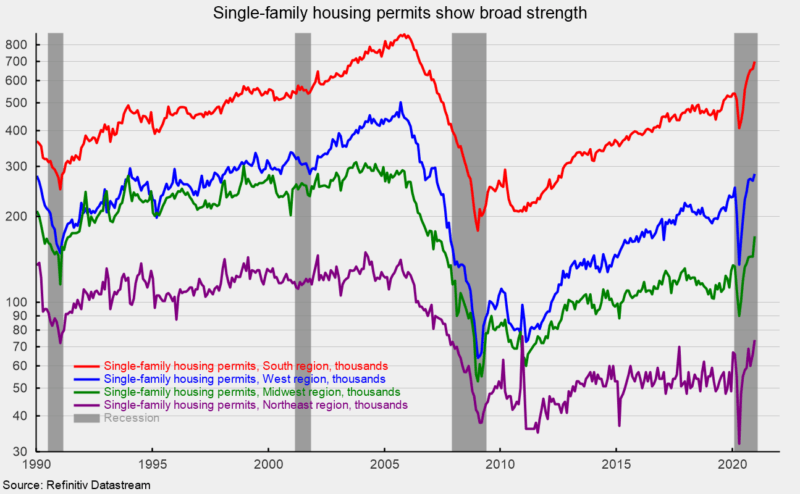Single-family homebuilding posted another strong performance as housing starts and permits rose again in December while homebuilder sentiment eased back but remained at a very high level. Total housing starts rose to a 1.669 million annual rate from a 1.578 million pace in November, a 5.8 percent increase. The December gain is the seventh rise in the last eight months since hitting an April low. From a year ago, total starts are up 5.2 percent.
The dominant single-family segment, which accounts for more than eighty percent of new home construction, rose 12.0 percent for the month to a rate of 1.338 million, the highest since September 2006 (see first chart). Single-family starts are up 27.8 percent from a year ago.
Starts of multifamily structures with five or more units fell 15.2 percent to 312,000 (see first chart) and are off 40.0 percent over the past year.
For housing permits, total permits rose 4.5 percent to 1.709 million in December. Total permits are 17.3 percent above the December 2019 level. Single-family permits were up 7.8 percent at 1.226 million, the highest rate since August 2006 (see first chart) while permits for two- to four-family units fell 11.5 percent to 46,000 and permits for five or more units dropped 2.0 percent to 437,000 (see first chart).
Overall, single-family starts and permits are showing persistent strength since the April low while multifamily starts and permits are trending sideways or slightly lower, but at a level well above the lows following the 2008-09 recession (see first chart).
Among the regions in the report, total starts rose in three of the four regions. The South, the largest region by volume, gained 5.5 percent while the West rose 10.2 percent and the Midwest jumped 32.1 percent. However, the Northeast plunged 34.8 percent in December.
For the single-family segment, the pattern was similar with the South up 8.2 percent, the West rising 0.6 percent, and the Midwest surging 66.9 percent while the Northeast dropped 4.8 percent.
For housing permits among the regions, total permits rose in three of the four regions. The Northeast lost 7.2 percent but the South increased 1.3 percent, the West rose 11.2 percent and the Midwest added 13.6 percent.
For the single-family segment, permits rose in all four regions. For the Northeast, the increase was 12.1 percent, the South gained 6.2 percent, the West rose 5.2 percent, and the Midwest gained 17.9. Single-family housing permits for all four regions are at multi-year highs (see second chart). All four regions also show strong double-digit gains from a year ago.
While current activity measures are very positive, the National Association of Home Builders’ Housing Market Index, a measure of homebuilder sentiment, fell slightly for a second consecutive month. The pullback is primarily due to surging materials costs, especially lumber, difficulty finding qualified labor, and resurging Covid-19 cases. Despite the decreases, overall sentiment remains relatively high.
The Housing Market Index fell to 83 in January, down from 86 in December but still a very positive level (see third chart). All three components of the index had declines in the latest month but also remained at very high levels (see third chart). On a regional basis, all four regions had declines in January but were also still at historically favorable levels.
Single-family home construction activity has recovered sharply since the April low as lockdown restrictions that impacted both construction workers and potential customers were eased. Furthermore, mortgage rates remain near all-time lows, providing support for the housing recovery though rising prices and tightening lending standards are headwinds for affordability and financing.
Housing is one of the areas that may be experiencing structural change. There appears to be sustained marginal demand for less dense suburban and rural housing as urban dwellers, primarily renters, seek alternative housing. This trend could be boosted if businesses implement permanent work from home policies, to make employees happy but also to cut down on high-cost commercial real estate, especially in high-density, high-cost cities.





0 Comments